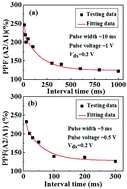Synaptic behaviors mimicked in indium-zinc-oxide transistors gated by high-proton-conducting graphene oxide-based composite solid electrolytes†
Abstract
The large protonic conductivity of proton conductor films is of considerable significance for low-power transistor-based synapse applications. In this work, a 3-triethoxysilylpropylamine graphene-oxide (KH550–GO) solid electrolyte with a protonic conductivity of ∼4.2 × 10−3 S cm−1 is synthesized and proposed to be used as a gate dielectric material for protonic/electronic hybrid synaptic transistors. The microstructure and the electrochemical characteristics of the KH550–GO solid electrolyte are investigated. In addition, the protonic/electronic hybrid synaptic transistor gated by KH550–GO can exhibit excellent electrical performance. Finally, the paired-pulse facilitation, excitatory post-synaptic current, and spike-rate-dependent plasticity of biological synapses are mimicked by such a synaptic transistor, which is, therefore, a promising artificial synapse for synaptic electronics and neuromorphic systems.


 Please wait while we load your content...
Please wait while we load your content...